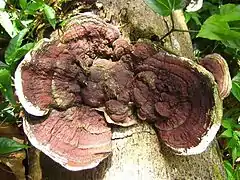| Earliella | |
|---|---|
 | |
| Scientific classification | |
| Kingdom: | |
| Division: | |
| Class: | |
| Order: | |
| Family: | |
| Genus: | Earliella Murrill (1905) |
| Type species | |
| Earliella scabrosa | |
| Synonyms[1] | |
Earliella is a fungal genus in the family Polyporaceae. It is a monotypic genus, containing the single species Earliella scabrosa.[2] It is found in Hainan.
Taxonomy
The genus was circumscribed by William Alphonso Murrill in 1905 with Earliella cubensis as the type species. The type collection was made in Cuba by Murrill and Franklin Sumner Earle, for whom the genus is named.[3] Murrill also noted the presence of the fungus in Nicaragua, Mexico, and Jamaica.[4] In a study of species described by Murrill,[5] Leif Ryvarden determined that Earliella cubensis was the same species as Trametes scabrosus (Pers.) Cunn., a possibility mentioned by Murrill himself.[4] Ryvarden and Robert Lee Gilbertson transferred Trametes scabrosus to Earliella in 1985.[6]
Chemistry
The chemical constituents and antioxidant activity of the essential oil extracted from fruit bodies of Earliella scabrosa has been characterized. The chemical 3-methyl-2-butanol is present in the highest concentration, accounting for nearly 50%. This is followed by diacetone alcohol (10.57%), azulene (8.01%), toluene (4.36%), palmitic acid (4.01%) and linoleic acid (4.01%).[7]
Pathogenicity
In 2017, a case report documented E. scabrosa as the cause of cutaneous fungal septic emboli in an immunocompromised child, which, despite antifungal treatment, later resulted in death.[8] A year later, the fungus was determined to be the cause of a human eye infection (endophthalmitis) resulting after intraocular lens implantation. It was successfully treated with a vitrectomy.[9]
References
- ↑ "Earliella scabrosa (Pers.) Gilb. & Ryvarden 1985". MycoBank. International Mycological Association. Retrieved 2010-11-18.
- ↑ Kirk, P.M.; Cannon, P.F.; Minter, D.W.; Stalpers, J.A. (2008). Dictionary of the Fungi (10th ed.). Wallingford, UK: CAB International. p. 225. ISBN 978-0-85199-826-8.
- ↑ Burkhardt, Lotte (2022). Eine Enzyklopädie zu eponymischen Pflanzennamen [Encyclopedia of eponymic plant names] (pdf) (in German). Berlin: Botanic Garden and Botanical Museum, Freie Universität Berlin. doi:10.3372/epolist2022. ISBN 978-3-946292-41-8. Retrieved January 27, 2022.
- 1 2 Murrill, W.A. (1905). "The Polyporaceae of North America: XII. A synopsis of the white and bright-colored pileate species". Bulletin of the Torrey Botanical Club. 32 (9): 469–493. doi:10.2307/2478463. JSTOR 2478463.
- ↑ Ryvarden, Leif (1985). "Type studies in the Polyporaceae 17. Species described by W.A. Merrill". Mycotaxon. 23: 169–198.
- ↑ Gilbertson, R.L.; Ryvarden, L. (1985). "Some new combinations in the Polyporaceae". Mycotaxon. 22 (2): 363–365.
- ↑ WanYing, Cen; XiaoNa, Yu; WenJie, Huang; Feng, Zhu; ChunFang, Chu (2016). "Chemical components and antioxidant activity of essential oil from Earliella scabrosa (Pers.) Gilb. & Ryvarden". Journal of Southern Agriculture. 47 (12): 2129–2133.
- ↑ Lim, Desmond Shi-Wei; Tan, Poh-Lin; Jureen, Roland; Tan, Kong-Bing (2017). "Cutaneous emboli of invasive basidiomycosis in a child with aplastic anemia". American Journal of Dermatopathology. 39 (3): 204–207. doi:10.1097/DAD.0000000000000699. PMID 28221210.
- ↑ He, Hong; Chen, Xiaolian; Liu, Hongshan; Wu, Jiaochan; Zhong, Xingwu (2018). "Earliella scabrosa-associated postoperative endophthalmitis after phacoemulsification with intraocular lens implantation: a case report". BMC Ophthalmology. 18 (1): 47. doi:10.1186/s12886-018-0702-9. PMC 5816531. PMID 29454335.
